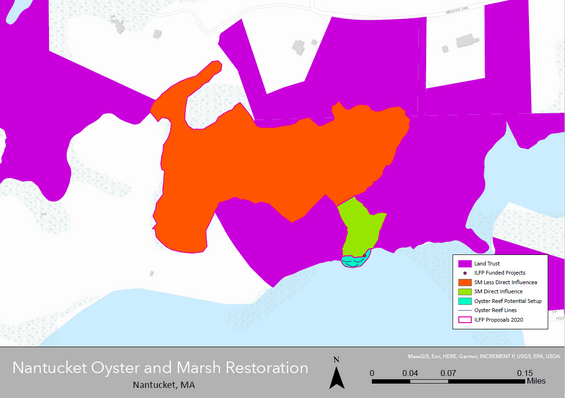Quick facts
ILF Funding: $84,270
ILF Service Area: Coastal—South Service Area
Project Location: Medouie Creek Estuary, Nantucket, MA (latitude: 41.306134, longitude: -70.01329)
Property size: 16.97 total; 0.17 acre of intertidal habitat, 16.8 acres of salt marsh
Project summary
Nantucket Conservation Foundation (NCF) is restoring a salt marsh on Nantucket. The restoration will take place in two parts. First, NCF will install oyster castles in Polpis Harbor. The castles will create habitat for marine life, including oysters. The castle structures will also promote natural water filtration, nutrient cycling, and help retain sediment next to the Medouie Creek salt marsh. Plants will be able to spread from the marsh onto the sediment, expanding the marsh to its original size before it eroded. The reef will have 3 linear reef structures covering 160–180 linear feet and about 0.17 acres of intertidal habitat. This design reduces erosion during regular tidal cycle and storm surges.
Second, NCF will restore about 1.1 acres of former salt marsh sediment, which has become bare sediment after purple marsh crab fed on many of the grasses. NCF will restore the bare sediment to salt marsh by removing crabs and planting new grasses as needed. Third, NCF will monitor the adjacent 15.7 acres of salt marsh for purple marsh crab and loss of vegetation. They will also remove crabs and plant grasses in this area as needed to make the restoration successful.
Medouie Creek was diked in the mid-1930s to build a road. A culvert was put under the road in 2008. This allowed saltwater to go under the road, allowing salt marsh grasses to grow on both sides of the road again. Surveys by the Salt Marsh Habitat and Avian Research Program program document salt marsh sparrow using restored marsh areas. This sparrow only nests in high marsh habitat, which will be lost as sea levels rise. This project helps prevent loss of high marsh habitat and ensures the area is part of a healthy tidal wetland landscape.

